Peacock cichlids have long been favored in the aquarium industry, and it’s easy to understand why.
There are tons of varieties to choose from, they boast beautiful colors, and they are more peaceful than many other cichlid species.
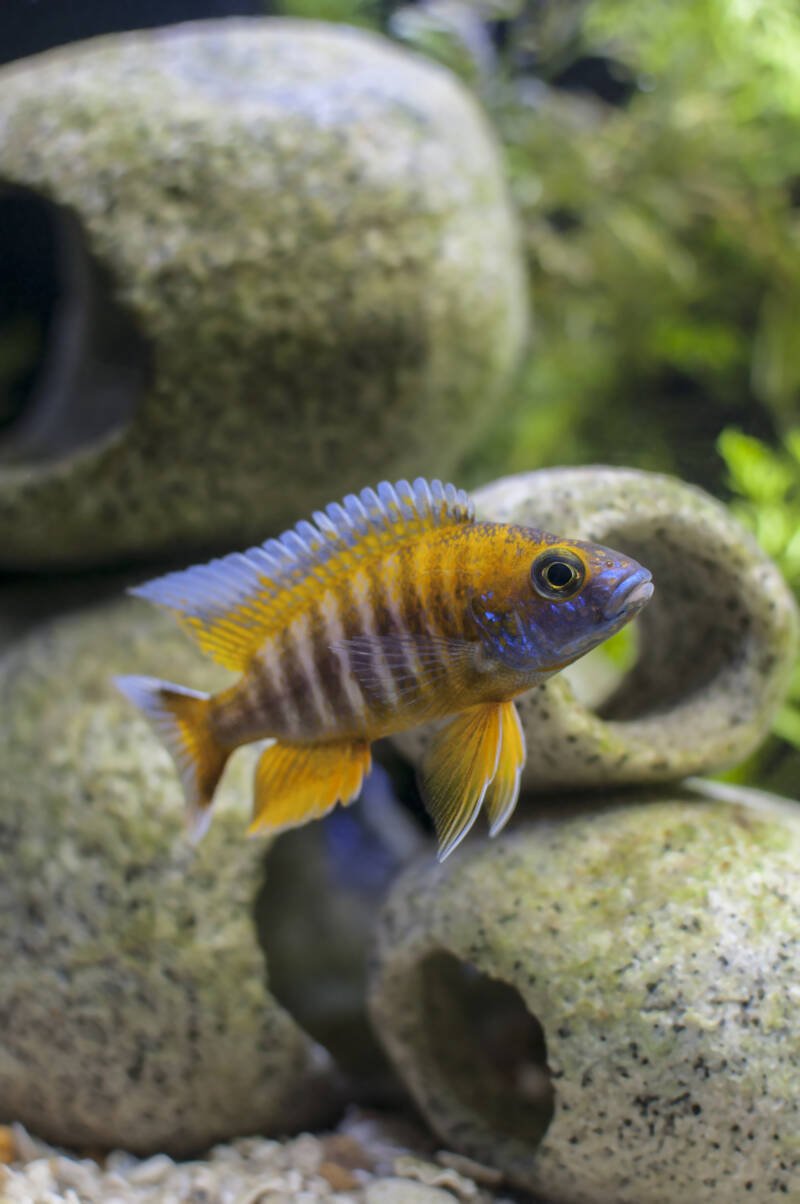
Indeed, the peacock cichlid has a feature to appeal to every aquarist.
Though peacocks are not recommended for beginner fish keepers, they are an excellent choice for beginner cichlid keepers.
They are relatively docile, easy to keep, and very hardy.
Experienced aquarists also appreciate them for their captivating behavior and laidback temperament in community tanks.
If you’re looking for a stunning cichlid for a species-only tank or as an addition to a current tank, look no farther than the peacock cichlid.
But deciding on a peacock isn’t the hard part— that comes when you have to pick between over a dozen gorgeous varieties!
In this article
Coloration, Size, & Lifespan

Peacock cichlids (Aulonocara) are a very colorful fish, as their name may indicate.
However, they don’t just favor the deep blues and greens found in peacocks. Instead, this fish features colors from every spectrum.
Whatever color you can name or think of, it’s sure to be featured on a peacock cichlid. It’s made even more impressive by the fact that there are at least 22 different species of peacock cichlids currently known.
And each variety is just as colorful as the last!
Not all species are available commercially, but many are sold in stores around the world. Some of the more popular types of peacock cichlids include:
- Sunshine Peacocks
- Butterfly Peacocks
- Dragon Blood Peacocks
- Lemon Jake Peacocks
- OB Peacocks
- Red Shoulder Peacocks
- Emperor Peacocks (also called Blue Peacocks)
- Red Peacocks (also called Grant’s Peacock)
Depending on the variety and gender, your cichlid will grow to roughly 4 – 6”.
This cichlid lives an average of eight years, longer than many freshwater fish but shorter than some other cichlid varieties.

Behavior
Peacock cichlids are classified as semi-aggressive because males can exhibit territorial behavior.
However, there are easy ways to curb these behaviors and precautions to prevent your peacock cichlids from becoming distressed.
On the whole, these are one of the most peaceful varieties of cichlids.
They’re popular amongst beginner cichlid keepers and experienced keepers who favor community tanks.
Natural Habitat
Peacock cichlids are originally from Lake Malawi, the southernmost lake in the East African Rift.
It is the fourth largest lake by volume globally and is close to 10 million years old.

Malawi lake houses many different ecosystems, and the animals within it have had years to evolve and breed.
Peacocks are no different, and most of the species can be found within this lake.
They are bottom dwellers, though they don’t inhabit the deepest parts of Lake Malawi.
Lake Malawi is over 2,300 ft. deep, but peacock cichlids usually prefer areas roughly 100 – 130 ft.
They prefer sandy areas in the lake bed and can often be seen hunting invertebrates there. This is said to be one of their most unusual and stunning behaviors to watch, both in the wild and in home aquariums.
Many African cichlids are aggressive toward other fish in their native habitat and captivity.
However, peacocks are surprisingly docile. They can be found peacefully living with many other types of fish.
Tank Setup
Peacock cichlids need a minimum of 55 gallons.
For community tanks, the gallon size should be at least doubled.
These active fish needs lots of surface area to explore and open space for swimming.
Preferably, only one male should be in the tank.
Female cichlids get along well and can be kept together, but males will become territorial. They may harass other males, females, or other tank mates.
These cichlids are very hardy. As such, they don’t need any specialized equipment.
Below is a basic rundown of what you’ll need for a cichlid tank:
- Filtration: Because they require large tanks, more filtration is always better than less. These fish can take a decent current, so almost any filter will work.
- Heating: These tropical fish will need warmer water, so a heater is required. A thermometer is also recommended to ensure the temperature is correct.
- Lighting: Almost any type of lighting will work for this fish, although cichlids may like a system that dims or can be customized to match their native habitat.
- Substrate: A fine sand substrate is required for peacock cichlids since they filter the substrate through their gills. Coarse substrates can cause gill damage.
- Driftwood: Peacock cichlids love driftwood. The more elaborate your setup, the better! They’ll have a blast exploring it and staking claims to different pieces.
- Stones: Feel free to scatter smooth stones across the sand and among the driftwood. It will enhance the natural feel of your tank and mimic the cichlid’s habitat.
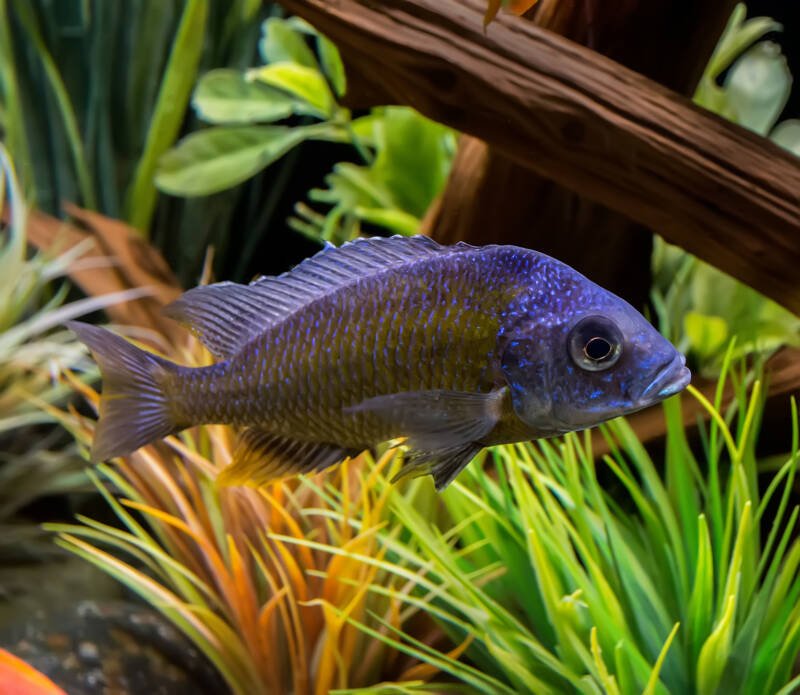
Another décor such as caves, terra cotta pots, and similar aquarium-safe hiding places can also be added. Cichlids will readily explore them and use them to stake out different territories.
Because of the depths, peacock cichlids inhabit in the wild, plants are more sparse and so are unnecessary in home aquariums. Cichlids may appreciate live plants, but otherwise, silk plants or a hardscape will work fine.
Water Parameters
Despite their hardy nature, peacock cichlids do have preferred water parameters that aquarists should adhere to.
It will keep your cichlids healthy and in a more peaceful mood.
- Temperature: these cichlids like water that’s between 76-82°F.
- pH Range: a pH range of anywhere between 7.5 – 8.5 is acceptable.
- Hardness: peacocks prefer water that’s 4 – 6 dH.
Weekly water changes are recommended to prevent ammonia, nitrites, and nitrates from getting above two ppm.
Levels are close to 0 ppm are preferred, but not always possible.
Without plants providing extra natural filtration, aquarists may need to invest in higher quality filtration systems to have a more strict cleaning regime.
In addition to weekly water changes, the sand substrate should be regularly combed. It prevents pockets of gas or debris from building up beneath the surface.
Such pockets can create water imbalances when finally popped and released into the tank, depending on how big the pocket was.
Tank Mates and Compatibility
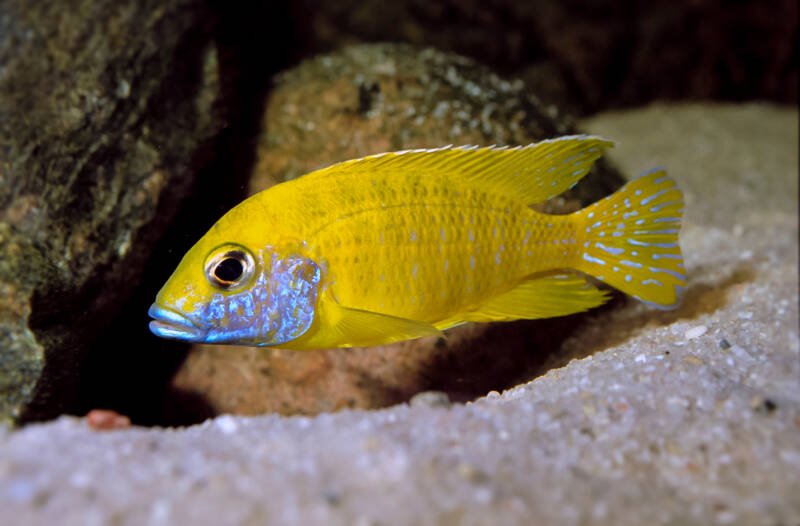
It’s best to house peacock cichlids with other fish that are peaceful and active.
Other aggressive fish will cause peacock cichlids to respond sharply, which should be avoided.
Shy fish may become more withdrawn due to the high activity level of peacocks.
Another consideration is to avoid other bottom dwellers so that these cichlids don’t have to share their space.
Though housing other bottom dwellers may be fine in large aquariums, it’s best avoided.
Keeping them with other African fish usually creates reliable results.
Some compatible tank mate species that peacocks are often housed with include:
Copadichromis
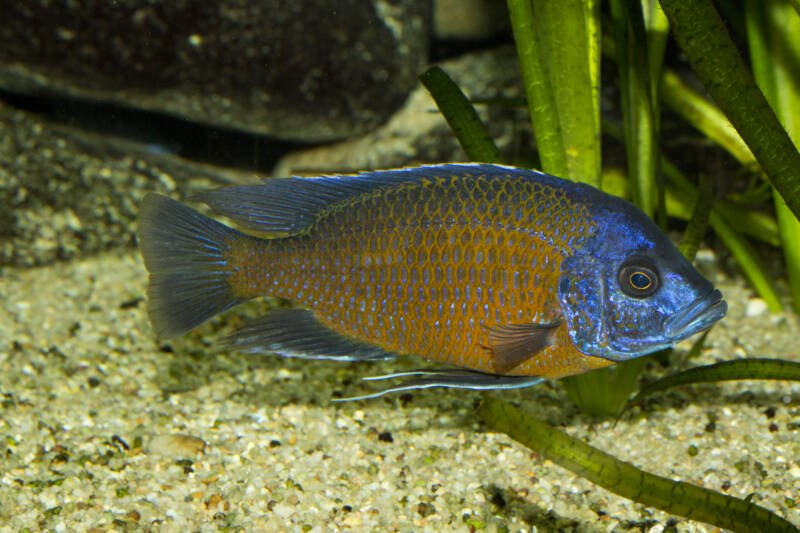
Placidochromis
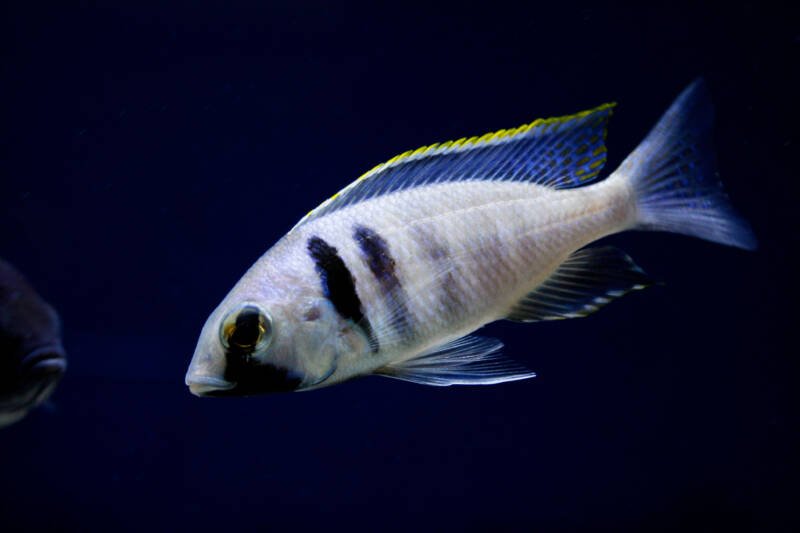
Otopharynx lithobates

Sciaenochromis

Many keepers have also reported success with adding snails to the aquarium.
It’s not recommended to keep multiple varieties of peacock cichlids together.
Though they get along, this can cause breeding issues later on (covered more in-depth later on).
Community aquariums with these fish are sure to be a stunning sight. However, species-only tanks are just as colorful.
Either way, hobbyists get to enjoy beautiful fish with striking appearances and fascinating behaviors.
Food and Diet
Peacock cichlids are omnivores that will eat just about anything.
A varied diet that heavily features meaty food is recommended. This will keep your cichlid in top shape and preserve its vibrant coloring.
Some foods that you can feed the peacock cichlids include:
- Bloodworms
- Earthworms
- Brine shrimp
- Tubifex
These cichlids will accept live, frozen, and freeze-dried foods.
Though, it’s best to make sure these foods sink quickly since peacocks are bottom dwellers and tend to stay in the lower and middle water columns.
Blanched vegetables can also be offered occasionally, such as spinach and lettuce.
High-quality fish flakes and pellets will also be readily accepted, but they should not comprise a significant part of the diet.
Cichlids should be fed at least once per day, with multiple feedings depending on the volume of the meals.
Breeding and Hybrid Issues

Because of their popularity and beauty, peacock cichlids are commonly bred in captivity. This is made easier by their willingness to do so, unlike some freshwater fish.
Peacock cichlids can be bred with members of their own species or with other species, creating hybrids.
Inter-species breeding is relatively common. It can be difficult to prevent in tanks with multiple species if the fish aren’t all females.
Hybrids are also tricky to identify in the aquarium trade.
Breeders and aquarists alike seek to produce the most vibrant colors, which may appear similar to one of the true 22 varieties.
Unfortunately, many hybrids are sterile despite their otherwise healthy appearance and body.
So if your cichlids consistently engage in breeding behavior, but no fertilized eggs or fry are produced, it’s likely at least one of your cichlids is a hybrid.
Obviously, you can’t prevent this in the industry at large and can’t do much if you already have a hybrid fish.
However, to prevent creating more hybrids, it’s wise not to keep multiple species of peacock cichlids together.
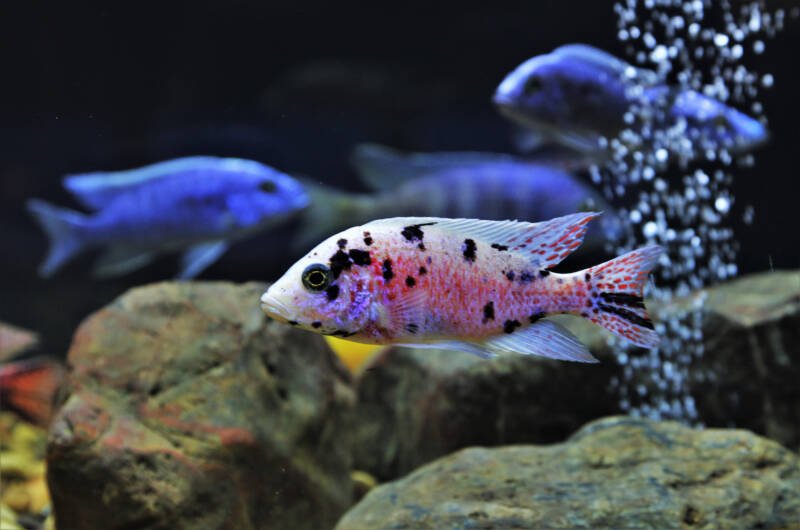
Closing Thoughts
Peacock cichlids may not be the easiest fish to keep due to their gallon and community tank requirements.
However, they are one of the easiest cichlids to keep. They are usually peaceful when kept in the right conditions.
Both experienced aquarists and beginner cichlid keepers can enjoy caring for peacock cichlids.
They are even easy to breed, which is a notable feat for freshwater fish species.
These cichlids are rewarding fish that offer beautiful colors and striking behaviors.
With over 20 varieties commercially available, peacock cichlids are an aquarium staple that is sure to last for years to come.